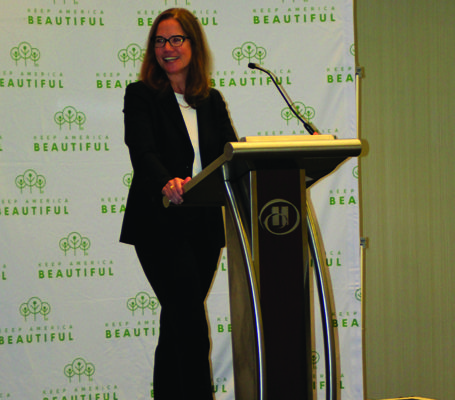The ability to recycle without driving an hour or more is far from a given in rural America. Access is a major challenge in meeting the goal to increase the national recycling rate to 50 percent by 2030. A preview of the EPA’s recycling strategy at the recent Keep America Beautiful 2021 Convention in Washington, D.C. was encouraging with less than a decade to hit that mark.
Nena Shaw, the EPA’s acting director for the Resource Conservation and Sustainability Division, presented the agency’s new strategy on the opening morning of the convention on America Recycles Day, Nov. 15. She framed the announcement as part of a circular economy for all.
“We know natural resource extractors and processing account for 50 percent of all greenhouse gases,” she said. “The EPA recognizes we must be more innovative. Sustainability from its foundation requires equity.”
The strategy’s success will depend on five objectives:
> Improving markets for recycled commodities
> Increasing collection of recyclable materials and improving recycling infrastructure through analysis
> Reducing contamination in recycled materials through outreach and education
> Enhance policies to support recycling
> Standardize measurement and increase data collection.
The strategy comes as the $1 trillion infrastructure bill includes $350 million for solid waste and recycling grants.
Shaw explained there has been a renewed focus at the federal level, “since China stopped taking our trash.” She said the focus is on relationships and communication. “We recognize broad federal support is needed.”
With Keep Alliance Beautiful and dozens of other affiliates in the room, attendees represented a range of local and state political climates. On a national level, however, Shaw said she is “encouraged there is bi-partisan support to address recycling . . . this is the first of many changes we will be doing to absorb all the changes on our plate.”
Earlier, discussion focused on the present backdrop for recycling. Billy Johnson, from the Institute of Scrap Recycling Industries, was the first speaker. On any given day there are one billion cans and bottles on the ground in the United States. Plastic may photodegrade, but the material is still there, it does not biodegrade. One-third of U.S. recycling goes abroad to 65-70 countries. Overall in our country, 80 percent of material being recycled is through the industrial and side. Of the 130 million metric tons of recycling, just 20 percent is through residential sources.
Johnson noted that the EPA is also looking at recycling in a different way as “one of the best tools to fight climate change.” The practice reduces virgin materials used and energy use. “In the last 5-6 years we have seen a big movement in recycling,” he added.
That morning, organizers repeated the mantra: Educate-Engage-Encourage. Millions of dollars in grants over five years may be what’s needed on a local level to spread the recycling message to our communities. Backing from the EPA and our lawmakers in Washington can only help facilitate the process.

